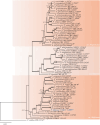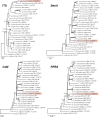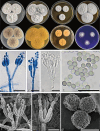Two new species of Penicillium (Eurotiales, Aspergillaceae) from China based on morphological and molecular analyses
- PMID: 40321907
- PMCID: PMC12048820
- DOI: 10.3897/mycokeys.116.149376
Two new species of Penicillium (Eurotiales, Aspergillaceae) from China based on morphological and molecular analyses
Abstract
Penicillium is a large and significant genus of fungi, exhibiting widespread distribution across diverse substrates. Ongoing taxonomic and nomenclatural revisions have led to an annual increase in the number of newly described species. This study described two new Penicillium species, i.e., P.lentum and P.tibetense, discovered in China. They have been identified and characterized through morphological examination and both single gene and multigene phylogenetic analyses. Based on these analyses, P.lentum was classified within the section Brevicompacta, while P.tibetense was placed in the section Lanata-Divaricata. Both species exhibited the morphological features typical of their respective sections. Penicilliumlentum is characterized by restricted growth with dense colonies on agar media and predominantly generates terverticillate conidiophores. Penicilliumtibetense demonstrates rapid growth on media and has vigorous growth on CYA at 30 °C, producing biverticillate conidiophores. Comprehensive descriptions and detailed illustrations of these new species were presented. A morphological comparison between the new species and their closely related taxa was provided.
Keywords: Aspergillaceae; DNA barcodes; section Brevicompacta; section Lanata-Divaricata; taxonomy.
Rui-Na Liang, Xiang-Hao Lin, Miao-Miao An, Guo-Zhu Zhao.
Conflict of interest statement
The authors have declared that no competing interests exist.
Figures






Similar articles
-
A review of recently introduced Aspergillus, Penicillium, Talaromyces and other Eurotiales species.Stud Mycol. 2024 Mar;107:1-66. doi: 10.3114/sim.2024.107.01. Epub 2024 Jan 10. Stud Mycol. 2024. PMID: 38600958 Free PMC article.
-
Morphological and phylogenetic analyses reveal two new Penicillium species isolated from the ancient Great Wall loess in Beijing, China.Front Microbiol. 2024 Mar 15;15:1329299. doi: 10.3389/fmicb.2024.1329299. eCollection 2024. Front Microbiol. 2024. PMID: 38559343 Free PMC article.
-
Species Diversity of Penicillium in Southwest China with Discovery of Forty-Three New Species.J Fungi (Basel). 2023 Nov 28;9(12):1150. doi: 10.3390/jof9121150. J Fungi (Basel). 2023. PMID: 38132751 Free PMC article.
-
Two new species of Penicillium and a new genus in Xylariomycetidae from the forest dump-sites in Chiang Mai, Thailand.MycoKeys. 2025 Apr 29;116:275-301. doi: 10.3897/mycokeys.116.150635. eCollection 2025. MycoKeys. 2025. PMID: 40337075 Free PMC article.
-
Seven New Species of Eurotiales (Ascomycota) Isolated from Tidal Flat Sediments in China.J Fungi (Basel). 2023 Sep 25;9(10):960. doi: 10.3390/jof9100960. J Fungi (Basel). 2023. PMID: 37888216 Free PMC article.
References
-
- Bandoh S, Takeuchi M, Ohsawa K, Higashihara K, Kawamoto Y, Goto T. (2009) Patulin distribution in decayed apple and its reduction. International Biodeterioration & Biodegradation 63: 379–382. 10.1016/j.ibiod.2008.10.010 - DOI
-
- Crous PW, Osieck ER, Shivas RG, Tan Y, Bishop-Hurley SL, Esteve-Raventós F, Larsson E, Luangsa-ard JJ, Pancorbo F, Balashov S, Baseia IG, Boekhout T, Chandranayaka S, Cowan DA, Cruz R, Czachura P, De la Peña-Lastra S, Dovana F, Drury B, Fell J, Flakus A, Fotedar R, Jurjevic Z, Kolecka A, Mack J, Maggs-Köllinh G, Mahadevakumar S, Mateos A, Mongkolsamrit S, Noisripoom W, Plaza M, Overy DP, Pigtek M, Sandoval-Denis M, Vauras J, Wingfield MJ, Abell SE, Ahmadpour A, Akulov A, Alavi F, Alavi Z, Altés A, Alvarado P, Anand G, Ashtekar N, Assyov B, Banc-Prandi G, Barbosa KD, Barreto GG, Bellanger JM, Bezerra JL, Bhat DJ, Bilanski P, Bose T, Bozok F, Chaves J, Costa-Rezende DH, Danteswari C, Darmostuk V, Delgado G, Denman S, Eichmeier A, Etayo J, Eyssartier G, Faulwetter S, Ganga KGG, Ghosta Y, Goh J, Góis JS, Gramaje D, Granit L, Groenewald M, Gulden G, Gusmao LFP, Hammerbacher A, Heidarian Z, Hywel-Jones N, Jankowiak R, Kaliyaperumal M, Kaygusuz O, Kezo K, Khonsanit A, Kumar S, Kuo CH, Læssre T, Latha KPD, Loizides M, Luo S, Macía-Vicente JG, Manimohan P, Marbach PAS, Marinho P, Marney TS, Marques G, Martín MP, Miller AN, Mondello F, Moreno G, Mufeeda KT, Mun HY, Nau T, Nkomo T, Okrasinska A, Oliveira J, Oliveira RL, Ortiz DA, Pawlowska J, Pérez-De-Gregorio MA, Podile AR, Portugal A, Privitera N, Rajeshkumar KC, Rauf I, Rian B, Rigueiro-Rodriguez A, Rivas-Torres GF, Rodriguez-Flakus P, Romero-Gordillo M, Saar I, Saba M, Santos CD, Sarma P, Siquier JL, Sleiman S, Spetik M, Sridhar KR, Stryjak-Bogacka M, Szczepanska K, Taskin H, Tennakoon DS, Thanakitpipattana D, Trovao J, Tüerkekul J, van Iperen AL, van ‘t P, Vasquez G, Visagie CM, Wingfield BD, Wong PTW, Yang WX, Yarar M, Yarden O, Yilmaz N, Zhang N, Zhu YN, Groenewald JZ. (2023) Fungal Planet description sheets: 1478–1549. Persoonia 50: 158–310. 10.3767/persoonia.2023.50.05 - DOI - PMC - PubMed
LinkOut - more resources
Full Text Sources
